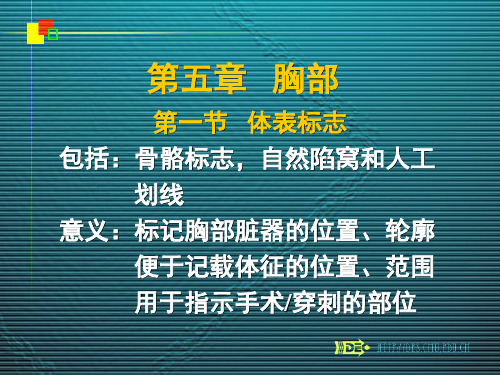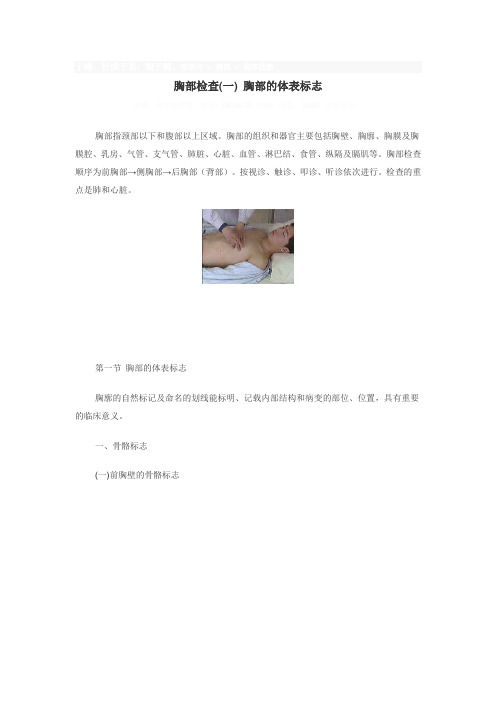医学-1胸部的体表标志熟悉胸部常用体表标志,包括骨骼标志、自然陷窝、
胸部体表标志

第一节 体表标志 包括:骨骼标志, 包括:骨骼标志,自然陷窝和人工 划线 意义:标记胸部脏器的位置、 意义:标记胸部脏器的位置、轮廓 便于记载体征的位置、 便于记载体征的位置、范围 用于指示手术/穿刺的部位 用于指示手术 穿刺的部位
一、骨骼标志 胸骨角:又称Louis角,为胸骨体、 胸骨角:又称 角 为胸骨体、 柄连接处 意义: 肋软骨相连, 意义:两侧与第 2 肋软骨相连,为 前面计数肋骨、 前面计数肋骨、肋间隙的标 与气管分叉、心房上缘、 志,与气管分叉、心房上缘、 上下纵隔分界、 胸椎(T4) 上下纵隔分界、第4胸椎 胸椎 体下缘齐平
因为:① 不在特定平面上所划垂直线, 因为: 不在特定平面上所划垂直线, 泛直是垂直地心的! 泛直是垂直地心的! 连接锁骨内外两端的直线, ② 连接锁骨内外两端的直线, 即使在坐位时,也并非水平。 即使在坐位时,也并非水平。 临床应用:判定心界大小, 临床应用:判定心界大小,在前胸测 肺下界、肺肝界, 肺下界、肺肝界,气胸穿 刺排气时常以此线作定位 标志。 标志。
三、肺和叶间胸膜的体表投影 右肺3叶 左肺2叶 右肺 叶,左肺 叶,发生肺部病 变位于哪叶,自胸背部体检根据 变位于哪叶, 异常体征进行判断, 异常体征进行判断,就必须牢记 两侧主叶间裂(胸膜) 两侧主叶间裂(胸膜)和右侧水 平裂在体表的具体投影位置
主叶间裂走行:后起自正中线第 主叶间裂走行: 3胸椎、向外下方斜行,于腋后线交 胸椎、 胸椎 向外下方斜行, 于第4肋骨,继续向前下延伸至第6 于第 肋骨,继续向前下延伸至第 肋骨 肋骨与肋软骨交接处。 肋骨与肋软骨交接处。 右水平裂:起自腋后线第4肋骨 肋骨, 右水平裂:起自腋后线第 肋骨, 前行止于第4肋间隙的胸骨右缘 肋间隙的胸骨右缘。 前行止于第 肋间隙的胸骨右缘。
胸部的体表标志

胸部的体表标志胸部体表标志包括骨骼标志、自然陷窝和人工划线或分区等,可用来标记胸部脏器的位置和轮廓,也可用于描述体征的位置和范围,还可用于指示穿刺或手术的部位。
如胸骨角平第2 肋软骨水平,胸腔穿刺抽液多在肩胛下角线第7~9 肋间。
一、骨骼标志胸骨上切迹(suprasternal notch)位于胸骨柄的上方。
正常情况下气管位于切迹正中。
胸骨柄(manubrum sterni)为胸骨上端略呈六角形的骨块。
其上部两侧与左右锁骨的胸骨端相连接,下方则与胸骨体连接。
胸骨角(sternal angle)又称Louis角。
为胸骨柄与胸骨体的连接处。
其两侧分别与左右第2 肋软骨相连接,胸骨角还标志气管分叉、心房上缘和上下纵隔交界及相当于第4 胸椎下缘水平。
剑突(xiphoid process)位于胸骨体下端,呈三角形,其底部与脚骨体相连,正常人剑突的长短差异很大。
腹上角为左右肋弓(由两侧的第7~10 肋软骨相互连接而成)在胸骨下端会合处所形成的夹角,又称胸骨下角(infrasternal angle)。
正常为70°~110°,体型瘦长者较小,矮胖者较大.深呼气时可稍增宽。
其后为肝脏左叶、胃及胰腺所在区域。
肋骨(rib )共12 对。
肋骨除被锁骨和肩胛骨掩盖部分外,大多能在胸壁触及。
在背部与相应的胸椎相连,由后上方向前下方倾斜。
其倾斜度上方略小,下方稍大。
第1 ~ 7 肋骨在前胸部通过各自的肋软骨与胸骨相连。
而第8 、9 、10 肋软骨通过上一肋软骨与胸骨相连。
第11 和12 肋骨不与胸骨相连,称为浮肋(free ribs)。
肋间隙(intercostal space)为两个肋骨之间的空隙,第一肋骨下面的间隙为第一肋间隙、第二肋骨下面的间隙为第二肋间隙,其余以此类推(图3-5-1 )。
肩胛骨(scapule )位于后胸壁第2 ~8 肋骨之间。
肩胛冈及其肩峰端均易触及。
肩胛骨呈三角形,其下部尖端称肩胛下角。
胸部体表标志及分区 胸廓胸壁乳房检查[严选材料]
![胸部体表标志及分区 胸廓胸壁乳房检查[严选材料]](https://img.taocdn.com/s3/m/87cfc457a8114431b80dd814.png)
锁关节-第1胸椎水平-锁骨中内1/3交 界处
肺外侧界:肺上界向下延伸,与侧胸
壁的内部表面相接触
肺内侧界:自上界胸锁关节处向下延
伸,在胸骨角水平处左右相遇,然后 分别沿前正中线两旁下行,至第四肋 软骨水平处分开,右侧几呈直线下行, 左侧沿心界下行,至第6肋软骨水平处 向两侧转折下行与肺下界连接。
水平裂:右肺上叶与中 叶的分界呈水平位
始于腋后线第4肋骨,
止于胸骨右缘第3肋间
隙
专业调研
14
肺部结构三维图视频
专业调研
15
练习小游戏
大家来找找胸部标志都在哪儿?
一突 二角 三区 四窝 七线
专业调研
16
第二节 胸廓、胸壁、乳房检查
专业调研
17
一、胸廓
(一)正常 构成:12个胸椎、12对肋骨、胸骨、锁
肋膈沟-下胸部前面的 肋骨常外翻,沿膈肌 附着的部位其胸壁向 专业调研内凹陷呈沟状带 22
4、漏斗胸
胸骨下端剑突 处内陷,形 似漏斗
见于佝偻病、 胸骨下部长 期受压
专业调研
23
佝偻病胸视频
专业调研
24
专业调研
25
5、胸廓一侧或局限性变形
膨隆:一侧膨隆伴肋间隙增宽,同时呼吸受限,气管、 心脏向健侧移位— —一侧大量胸水、气胸、液气胸、 巨大肿物,患侧呼吸障碍健侧代偿性肺气肿而膨隆
二、胸部检查的内容:胸壁、胸廓、乳房、纵隔、气管、肺、 胸膜、心脏、血管和淋巴结
三、检查方法:视、触、叩、听
四、检查要求:
★温度合适
★光线充足
★暴露全胸
★坐位/卧位
★检查时尽量减少患者的不适和不必要的体位变动
胸部检查(一) 胸部的体表标志

于嬉;行成于思,毁于随。
医学习 > 病房 > 临床技能胸部检查(一) 胸部的体表标志来源:济宁医学院发表:08-04-26 11:50 浏览:2545 字号大小:胸部指颈部以下和腹部以上区域。
胸部的组织和器官主要包括胸壁、胸廓、胸膜及胸膜腔、乳房、气管、支气管、肺脏、心脏、血管、淋巴结、食管、纵隔及膈肌等。
胸部检查顺序为前胸部→侧胸部→后胸部(背部)。
按视诊、触诊、叩诊、听诊依次进行。
检查的重点是肺和心脏。
第一节胸部的体表标志胸廓的自然标记及命名的划线能标明、记载内部结构和病变的部位、位置,具有重要的临床意义。
一、骨骼标志(一)前胸壁的骨骼标志胸部的标志及标志线1.胸骨(sternum) 位于胸廓前正中,连接两侧肋骨和锁骨,分为胸骨柄、胸骨体、剑突三部分。
(1)胸骨柄(manubrium sterni) 位于胸骨的上部,外形略呈六角形。
胸骨柄上缘中部为颈静脉切迹,在成人约平第二胸椎下方的椎间盘,上缘两外侧的卵圆形关节面,称为锁骨切迹,与锁骨的胸骨端相连接,下缘与胸骨体相连。
(2)胸骨体(corpus sterni) 胸骨的中间部分,其上缘与胸骨柄相接,下缘与剑突相结合。
胸骨体下部的两侧与第7~10肋软骨连接。
(3)剑突(xiphoid process) 为胸骨体下端的突出部分,呈三角形,其底部与胸骨体相连。
2.胸骨角(sternal angle) 又称Louis角。
由胸骨柄和胸骨体连接处稍向前方突起而成。
胸骨角的部位标志着气管的分叉处、主动脉弓的上缘及第四胸椎的高度。
胸骨角与第二肋软骨相连,为计数肋骨的重要标志。
3.肋间隙(intercostal space) 两肋骨之间的空隙。
前胸壁的水平位置常用肋骨或者肋间隙表示,第一、二肋骨之间的间隙为第一肋间隙,以此类推。
(二)后胸壁(背部)的骨骼标志背部骨性标志1.脊椎棘突(processus spinosus) 后正中线上每个椎骨间后方的骨性突起。
胸部检查第一节胸部的体表标志与常用标记线

胸部的体表标志
胸骨上窝:位于胸骨柄的上方,是气管和胸骨的标志 锁骨上窝:位于锁骨中部的上方,是淋巴结和胸膜顶的标志 肋间隙:肋骨之间的间隙,是胸腔内器官的重要标志 剑突:胸骨下方的突出部分,是心脏的重要标志
胸部的分区
胸部的体表标志:胸骨、胸骨上窝、锁骨、肋骨等 胸部的分区:前胸区、侧胸区、后胸区 胸部的常用标记线:前正中线、锁骨中线、腋前线、腋中线、腋后线等 胸部的常用标记点:胸骨上窝、锁骨中点、肋骨角等
XX,a click to unlimited possibilities
胸部的体表标志与常 用标记线
汇报人:XX
CONTENTS
目 录
01 单击添加目录标题 02 胸部的体表标志 03 胸部的常用标记线
01
添加章节标题
02
胸部的体表标志
胸部的骨性标志
胸骨上切迹:位于胸骨的最上方,两侧水平走行,呈横行凹陷 胸骨柄:位于胸骨上切迹下,两侧水平走行,呈横行凸起 胸骨角:位于胸骨柄与胸骨体交界处,呈横行凸起,两侧平对第二肋骨 剑突:位于胸骨体的下方,呈三角形或菱形,下方为凹形 肋骨:呈水平走行,共12对,其中第1-7肋骨前端与胸骨相连,称为真肋;第8-12肋骨前端借肋软骨与上位肋骨相连,称为假肋
腋后线
定义:沿腋窝后缘与胸部正中 垂直线平行的线
用途:用于定位胸部器官和手 术切口
标记方法:在患者体表使用标 记笔或绷带标记
注意事项:标记线应清晰可见, 便于手术操作
THANK YOU
汇报人:XX
位置:起始于腋窝前缘,沿腋窝前缘向下延伸至第4肋间
临床意义:在胸部手术中,腋前线常作为手术切口的标记线,便于手术操作和术后护理
腋中线
定义:沿腋窝中点的垂直线 用途:标记胸部的水平位置,常用于定位肋骨和胸骨的位置 注意事项:在腋中线上的标记线可以帮助确定胸腔器官的位置和对称性 与其他标记线的区别:与腋前线和腋后线不同,腋中线主要用于确定胸部水平位置的标记
呼吸系统评估3

3、节律变化:
(1)潮式呼吸:
浅慢---深快---浅慢---暂停 周期30秒至2分钟 ,暂停时间可长 达5~30秒
意义:脑炎、脑膜炎、高颅压 轻度:正常老年人睡眠时
(2) 间停..: 规律呼吸—停止
呼吸深度相等 呼吸暂停的时间长 呼吸次数明显减少 脑损伤,临终前
(3) 叹息样..: 正常---深大----正常 紧张、抑郁症
一、胸部的体表标志 二、胸壁、胸廓与乳房 三、肺和胸膜
一、胸部的体表标志
(一)骨骼标志
1、胸骨角 2、剑突 3、腹上角 4、肋间隙 5、肩胛骨 6、脊柱棘突 7、肋脊角
(二)自然陷窝
1、胸骨上窝 2、锁骨上、下窝 3、腋窝
4、肩胛上区 5、肩胛下区 6、肩胛间区
(三)人工划线
1、前正中线 2、锁骨中线 3、胸骨线 4、胸骨旁线 5、腋前线 6、腋后线 7、腋中线 8、后正中线 9、肩胛线
周期30秒至2分钟 ,暂停时间可长达5~30秒 视诊:胸廓对称,饱满,肋间隙增宽,桶状,呼吸动度减弱 (2)特点:
(3)分类:
粗湿啰音(痰鸣) 中等湿啰音 细湿啰音 捻发音
(4) 临床意义:
局限:肺炎、肺结核或支气管扩张 两肺底:心衰 两肺野:急性肺水肿或严重的支气管炎
总结
4、语音共振 同触觉语颤机制相似 临床意义同上
肋骨串珠与肋膈沟
漏斗胸
4、胸廓一侧变形: 5、隆起 :胸腔积液、气胸 6、凹陷 :肺不张、肺纤维化
7、脊柱变形:脊柱结核; 外伤
总结:常见胸廓畸形
三、肺和胸膜
(一)视诊 (二)触诊 (三)叩诊 (四)听诊
(一)视诊
1、呼吸运动 (1)正常:
类型:
腹式呼吸:以膈肌运动为主 :男、儿童 胸式呼吸:以肋间肌、、 :女性
胸部的体表标志

Textbook of Physical Diagnosis : History and Examination, 6th Edition
精品课件
Questions & Comments
精品课件
每侧的肋胸膜与膈胸膜于肺下界以下的 转折处
约有二三个肋间高度 由于其位置最低,当深吸气时也不能完
全被扩张的肺所充满
精品课件
推荐阅读
Mosby's Guide to Physical Examination, 7th Edition
Bates' Guide to Physical Examination and History Taking, 10th Edition
精品课件
肺下界
左右两侧肺下界的位置 基本相似
前胸部的肺下界始于第6 肋骨,向两侧斜行向下 ,于锁骨中线处达第6肋 间隙,至腋中线处达第8 肋间隙
后胸壁的肺下界几乎呈 一水平线,于肩胛线处 位于第10肋骨水平
精品课件
叶间隙
斜裂
右肺上叶和中叶与下 叶之间的叶间隙和左 肺上、下叶之间的叶 间隙
精品课件
腹上角
正常约70~ll0° 体型瘦长者角度较小,
矮胖者较大,深吸气时 可稍增宽 其后为肝脏左叶、胃及 胰腺的所在区域
精品课件
剑突(xiphoid process)
胸骨体下端的突 出部分
呈三角形,其底 部与胸骨体相连
剑突的长短存在 很大的差异
精品课件
肋骨(rib)
第1~7肋骨在前胸部 与各自的肋软骨连接
胸骨角(sternal angle)
胸部体表标志

龙源期刊网
胸部体表标志
作者:
来源:《中国社区医师》2013年第21期
胸部体表标志的准确认定,便于我们判定胸部脏器投影,同时也利于我们对病理异常变化的描述、定位与记录,它对临床工作实践是十分重要的。
主要的胸部体表标志
骨骼标志前面:胸骨上切迹、胸骨桶胸骨角剑突肋骨肋间隙后面:肩胛骨、脊柱棘
突、脊肋角。
垂直线标志前面:正中线、锁骨中线、胸骨线、胸骨旁线、腋前线;侧面:腋前线、腋
中线、腋后线;后面:活动肩胛骨后确定肩胛线、后正中线。
自然陷窝和解剖区域前面:胸骨上窝、锁骨上窝、锁骨下窝、腋窝;后面:肩胛上区、
肩胛下区、肩胛间区。
肺和胸膜的界限肺尖、肺上界、肺内侧界、肺外侧界、肺下界、胸膜。
注意事项
胸部体表标志,多数是利用解剖的自然标志点来确定的,只有垂直线标志是人为描画的,必须准确的牢记其位置,不能混淆。
第四章 体格检查胸部检查(含心肺听诊)

(一)胸部视诊1.胸部的体表标志包括骨骼标志、垂直线标志、自然陷窝、肺和胸膜的界限。
(1)骨性标志1)胸骨角(Louis角):胸骨柄与胸骨体的连接处,其两侧分别与左右第二肋软骨相连接。
平气管分叉、心房上缘、上下纵隔交界、第4胸椎下缘。
2)肩胛骨:被检查者双臂下垂,肩胛下角平第7肋骨水平或第7肋间隙,或相当于第8胸椎水平。
3)C7棘突:最明显的棘突,用于计数椎体。
4)肋脊角:第12肋与脊柱的成角,其为肾脏和输尿管起始部。
(2)重要的人工划线:包括前正中线、锁骨中线、腋前线、腋中线、腋后线、肩胛下角线、后正中线。
其中标注锁骨中线时,利用直尺测定锁骨胸骨端和肩峰端之间的中点,然后用皮尺向下引,测量并记录锁骨中线距离前正中线之间的投影距离,作为心脏测量的参照。
(3)胸部陷窝:包括腋窝、胸骨上窝、锁骨上窝等。
其中腋窝和锁骨上窝是触诊浅表淋巴结的重要部位。
(4)肺和胸膜的界限:肺下界最为重要,分别位于锁骨中线第6肋间、腋中线第8肋间、肩胛线第10肋间。
2.胸壁、胸廓(1)胸壁:观察胸壁静脉有无充盈、曲,血流方向。
前胸壁静脉曲,血流方向向下见于上腔静脉阻塞。
侧胸壁和腹壁静脉曲,血流方向向上见于下腔静脉阻塞。
观察有无皮疹、蜘蛛痣。
(2)胸廓:观察胸廓形态。
正常胸廓两侧大致对称,呈椭圆形,前后径:左右径约为1:1.5。
1)异常胸廓:①桶状胸:前后径:左右径≥1,同时伴肋间隙增宽,见于肺气肿。
②佝偻病胸:为佝偻病所致胸廓改变。
包括佝偻病串珠、漏斗胸、鸡胸。
③脊柱畸形所致胸廓畸形:脊柱前凸、后凸或侧凸均可造成胸廓形态异常。
2)单侧胸廓形态异常:单侧胸廓膨隆:见于大量胸腔积液、气胸等;单侧胸廓塌陷:见于胸膜肥厚粘连、大面积肺不、肺叶切除术后等。
3.呼吸运动、呼吸频率和节律、呼吸时相。
(1)呼吸运动1)正常的呼吸运动:胸式呼吸多见于成年女性;腹式呼吸多见于成年男性及儿童。
2)呼吸运动类型变化及其临床意义:①胸式呼吸减弱或消失:见于肺及胸膜炎症、胸壁或肋骨病变;②腹式呼吸减弱或消失:见于腹膜炎、大量腹水、肝脾极度肿大、腹腔巨大肿物、妊娠。
胸部的体表标志

肺上界
于前胸壁的投影 呈一向上凸起的 弧线。然后转折 向下至锁骨中1/ 3与内1/3交界 处。
肺外侧界
由肺上界向下延 伸而成,几乎与 侧胸壁的内部表 面相接触。
肺内侧界
自胸锁关节处下行,于胸骨 角水平处左右两肺的前内界 几乎相遇。然后分别沿前正 中线两旁下行,至第4肋软 骨水平处分开,右侧几乎呈 直线继续向下,至第6肋软 骨水平处转折向右,下行与 右肺下界连接。左侧于第4 肋软骨水平处向左达第4肋 骨前端,沿第4~6肋骨的前 面向下,至第6肋软骨水平 处再向左,下行与左肺下界 连接。
为计数肋骨和肋间 隙顺序的主要标志
标志支气管分叉、 心房上缘和上下纵 隔交界及相当于第 5胸椎的水平
腹上角
左右肋弓(由两侧的 第7~10肋软骨相互 连接而成)在胸骨下 端会合处所形成的夹 角
又称胸骨下角 (infrasternal angle)
相当于横膈的穹隆部
腹上角
正常约70~ll0° 体型瘦长者角度较小,
肋脊角(costal spinal angle)
第12肋骨与脊 柱构成的夹角
其前为肾脏和输 尿管上端所在的 区域
垂直线标志
前正中线 锁骨中线 胸骨线 胸骨旁线
腋前线 腋后线 腋中线 肩胛线 后正中线
前正中线(anterior midline)
胸骨中线,通过胸 骨正中的垂直线
后正中线(posterior midline)
即脊柱中线 通过椎骨棘突,
或沿脊柱正中下 行的垂直线。
肩胛线(scapular line)
双臂下垂时通过 肩胛下角与后正 中线平行的垂直 线
自然陷窝和解剖区域
腋窝 胸骨上窝 锁骨上窝 锁骨下窝
健康评估:胸部的体表标志

• 腋前线 • 腋中线 • 腋后线
自然陷窝
前面与侧面
• 胸骨上窝 • 锁骨上窝 • 腋窝
自然陷窝
后面
• 肩胛上区 • 肩胛下区 • 肩胛间区
THANKS
骨骼标志
腹上角
• 左右肋弓在胸骨下端 左右汇合处所形成的 夹角,正常约70110°。瘦长体型者 角度较锐,矮胖体型 者角度较钝。
骨骼标志
肋间隙
• 2个肋骨之间的间隙, 用来标记病变的水平 位置。
骨骼标志
肩胛骨
• 肩胛骨最下端为肩胛 下角
• 直立位双臂自然下垂 时 , 肩 胛 下 角 平第7、 或8肋骨水平,或相当 于第8胸椎水平。
胸部的体表标志
胸部的体表标志
• 骨骼标志 • 自然陷窝 • 线性标志和分区
骨骼标志
胸骨
• 位于前胸壁正中, 自上而志
胸骨角
• 第二肋软骨连接处、与 第四胸椎相平、气管分 叉处、主动脉弓上缘、 上下纵隔交界处
骨骼标志
剑突
• 胸骨体下端的突出 部分,成三角形, 其底部与胸骨体相 连
骨骼标志
肋脊角
• 第12肋骨与脊柱构成的 夹角,其前方为肾脏和 输尿管上端所在的区域。
骨骼标志
脊柱棘突
• 后正中线的标志 • 第7颈椎棘突最突出,
下为第1胸椎,用来 计数胸椎的标志。
线性标志
前面
• 前正中线 • 锁骨中线 • 胸骨线 • 胸骨旁线
线性标志
后面
• 后正中线 • 肩胛线
线性标志
- 1、下载文档前请自行甄别文档内容的完整性,平台不提供额外的编辑、内容补充、找答案等附加服务。
- 2、"仅部分预览"的文档,不可在线预览部分如存在完整性等问题,可反馈申请退款(可完整预览的文档不适用该条件!)。
- 3、如文档侵犯您的权益,请联系客服反馈,我们会尽快为您处理(人工客服工作时间:9:00-18:30)。
C.叩诊 10.叩诊锁骨上窝, 11.叩诊后胸部; 12.叩诊肺下界(肩胛下线); 13. 肩胛下线叩诊肺下界移动度: 14.叩诊前、侧胸部; D.听诊 15.听诊锁骨上窝; 16.听诊前、侧胸部; 17.听诊后胸部; 18.检查有无胸膜摩擦音; 19.检查听觉语音。
A.Review
1.Review skeleta1 1andmarks. 2.topographic description of location for any
Natural fossa & anatomic region
Axillary fossa Supraclavicular fossa Suprasternal fossa Infraclavicular fossa Suprascapular region Infrascapular region Interscapular region
1.胸部的体表标志 熟悉胸部常用体表标志, 包括骨骼标志、自然陷窝、人工划线和分区。
胸壁、胸廓和乳房 了解异常胸壁、胸廓的临 床特征,熟悉其发生原因。
肺和胸膜
(1)视诊:要求了解呼吸运动的类型、各类 呼吸困难的特征、呼吸频率和深度改变及意义。
(2)触诊:熟悉肺部触诊内容。掌握肺部触 诊的检查方法,胸廓扩张度改变和触觉语颤异 常的临床意义。
The boundary of lung & pleura
Lung apex Upper boundary of the lung Outer boundary Inner boundary Lower boundary:
Midclavicular line Midaxillary line Inferior line
scapular lines. 16.Percuss the anterior and lateral chest.
Mention of Conduction
Exposure/warmth/lighting /easy air Inspection, palpation, percussion, auscultation Anterior-lateral-posterior Top- base Comparison: top to base/ left to right
6th interspace 8th interspace 10th interspace
Chest wall
Vein : Blood flow direction Subcutaneius emphysema(皮下气肿) Tenderness Interspace
骨性标志包括:胸骨角、腹上角、胸 骨剑突、肋骨、肋间隙、肩胛骨、肋脊 角。
自然陷窝 :锁骨上窝、锁骨下窝、
人工划线包括;前正中线、左、右锁 骨中线、腋前线、腋中线、腋后线、后 正中线、肩胛线。
胸部体格检查纲要
A.视诊 1.检查者应面对病人站立,观察胸廓外形和对称性; 2.观察呼吸形态; B.触诊 3.触诊腋下淋巴结; 4.触诊胸壁有无压痛; 5.触诊乳房; 6.在前胸检查呼吸动度: 7.在后胸检查呼吸动度; 8.触诊胸膜摩擦感; 9.检查触觉语颤;
(3)叩诊:了解直接和间接叩诊法的检查方 法与应用、影响叩诊音的因素。熟悉胸部叩 诊音的分类,肺下界移动度的叩诊方法。掌 握肺部叩诊音和肺下界移动度改变的临床意 义。
(4)听诊:了解胸膜摩擦音的听诊特点和临 床意义。熟悉正常呼吸音的种类、特点及分 布。啰音的发生机制、分类和听诊特点,语 音共振的检查法及临床意义。掌握病理性呼 吸音听诊的特点和临床意义。干、湿啰音产 生的临床意义。
Bone landபைடு நூலகம்ark
suprasternal notch(胸骨上切迹) clavicle(锁骨) Manubrium sterni(胸骨柄) Sternal angle(胸骨角) Louis angle suprabdominal angle(腹上角) xiphoid process(剑突) Ribs & interspaces scapula(肩胛骨) spinous process(棘突) costolspinal angle(肋脊角)
positive physical findings:normal or abnormal.
B.Methods
3. Examiner should stand facing the patient and observe the shape and symmetry of the chest.
4. Measure respiratory rate. 5. palpate trachea and ev1uate position of the
trachea. 6. palpate for tenderness.
7.Breasts. 8.Evaluate posterior chest excursion. 9.EvaIuate Anterior Chest excursion. 10.Palpate for pleural friction rubs. 11.Check for tactile fremitus. 12.Percuss supraclavicutar fosiae. 13.Percuss the posterior chest. 14.Percuss the lower margin of the lungs. 15.Percuss to detect diaPhragmatic movement at
Vertical lines
Anterior middle line(前正中线) Mid-clavicular lines(锁骨中线) Spinal line(后正中线) axillary lines (anterior,middle, posterior)
(腋前、中、后线) Scapular lines(肩胛线)
